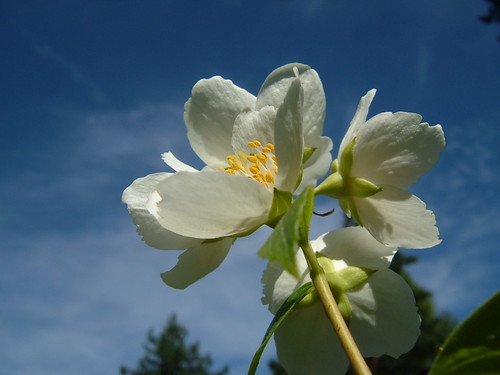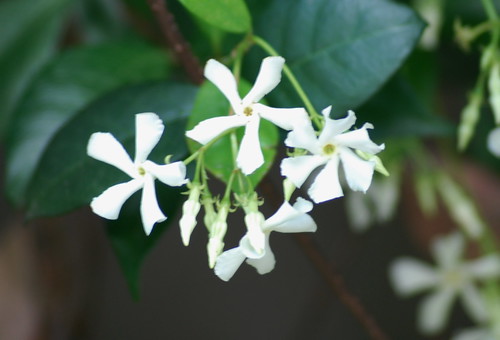In Mandy Aftel’s book, Fragrant, she calls this perfume simply “Jasmine,” but it’s more of a lovely dance between Jasmine and Lavender Concrete, while the Blood Orange also adds a delicious and plush fruity top note.
Here’s what you need to create Orange-Jasmine-Lavender solid perfume:
Raw Materials*
- Jojoba oil
- Grated beeswax
- Jasmine Grandiflorum absolute
- Jasmine Sambac absolute
- Blood Orange essential oil
- Lavender concrete
*Out of courtesy to the author, I’m leaving off the amounts of each raw material. You can find them in her book.
Equipment
- Box grater (for grating beeswax)
- Measuring spoons (for beeswax)
- 80 ml lab casserole (for melting beeswax)
- 10 ml graduated beaker or cylinder
- Glass eyedroppers (1 per essence)
- Small glass of alcohol for cleaning eye droppers (place them in it upright after use)
- Stirring rod
- Hot plate (can also use stovetop burner)
- ½ oz tin (for storing perfume)
- Paper towels
Steps
- Cover your work surface with paper towels.
- Add the Jojoba oil to the graduated beaker.
- Next, measure out the lavender concrete into the beaker of oil. Aftel’s recipe calls for the lavender concrete in grams, because it is typically a paste. The version I have is liquid, so I added drops until they equaled the required weight. I found that 6 drops matched the gram weight she specified.
- Then add both kinds of jasmine, and finally the blood orange. Smell after each addition to experience how the blend is evolving.
- When you are done with an eye dropper, place it in the glass of alcohol, and pump it a few times to clean it, and leave it sitting full of alcohol. This prevents cross contamination.
- Measure out the grated beeswax into the lab casserole. Hold the lab casserole over the burner until the wax melts.
- Quickly pour the essential oil blend into the liquid wax. Working over the heat, stir the blend into the wax for about 10 seconds until it’s a smooth mixture.
- Finally, pour the molten perfume into the ½ oz tin, cap it, and leave it alone for 15 minutes to solidify. Finis!
How did it work? How does it smell?
The blood orange top note is gorgeous! This is a full-bodied, voluptuous orange – and it pairs well with jasmine. I can see why Mandy picked it rather than a thinner or more bitter citrus note (wild orange, bitter orange, etc.). It enhances the rich, fruity, and sweet qualities of the jasmine and this is my favorite phase of the perfume. The two types of jasmine produce a more complex effect, capitalizing on both the lush, rounded sweetness of the Grandiflorum and the greener, fresher, spicier quality of the Sambac. The Lavender concrete provides a soft, herbaceous and green base for everything and is fore-grounded more in the dry down; it’s slightly “soapy” in Mandy’s words, and I have to agree. The Lavender concrete is perfectly fine, but I don’t looooove it the way I love Lavender absolute, which is more floral, so I can’t help but wonder what this would smell like with the absolute instead of the concrete. Better? Or less interesting because less contrast?
I also have to wonder how different my own blend might smell simply due to different natural materials. I contacted Mandy about the Lavender Concrete issue (mine is liquid, her recipe calls for a solid) – and she said her own was a paste which is why she used the weight-based measurements, so she was unsure how mine would compare. I managed to source two concretes – one from Liberty Naturals and one from Samara Botane – but BOTH were liquid. So who knows, maybe it’s just how this year’s harvest behaved? Both companies noted that the consistency of this material could vary. I would love to smell Mandy’s composition and this one side-by-side to discover the difference.
Notes on Notes
- Jasmine Grandiflorum Absolute, India, Eden Botanicals – Jasmine, white floral, SWEET, smooth, round, narcotic
- Jasmine Sambac Absolute, India, Eden Botanicals – GREEN, spicy. Smells surprisingly different from the Grandiflorum. Harder to find the flower. Sweet in its own right, but it’s harder to smell the sweetness after being beaten senseless by the Grandiflorum.
- Blood Orange EO, Italy, Eden Botanicals – Tart/Sour Citrus; “more” than Bergamot. More body. More heft. Less ephemeral. Tart like a grapefruit, but still sweet with a juicier, orangier character.
- Lavender Concrete, Lavandula Officinalis, France, Liberty Naturals – herbaceous, green, soft


